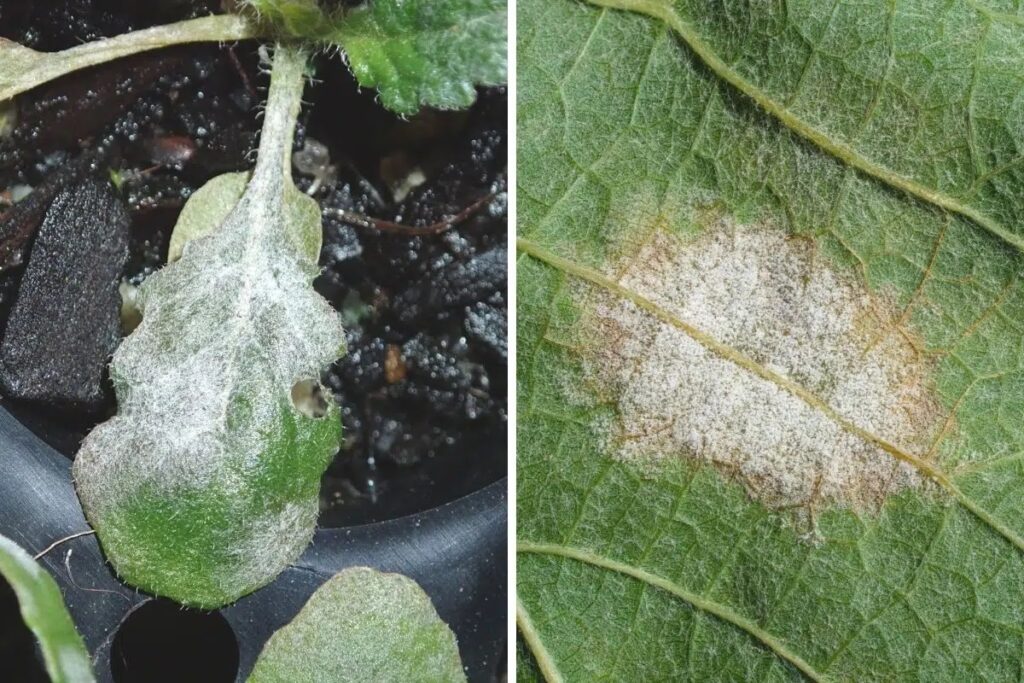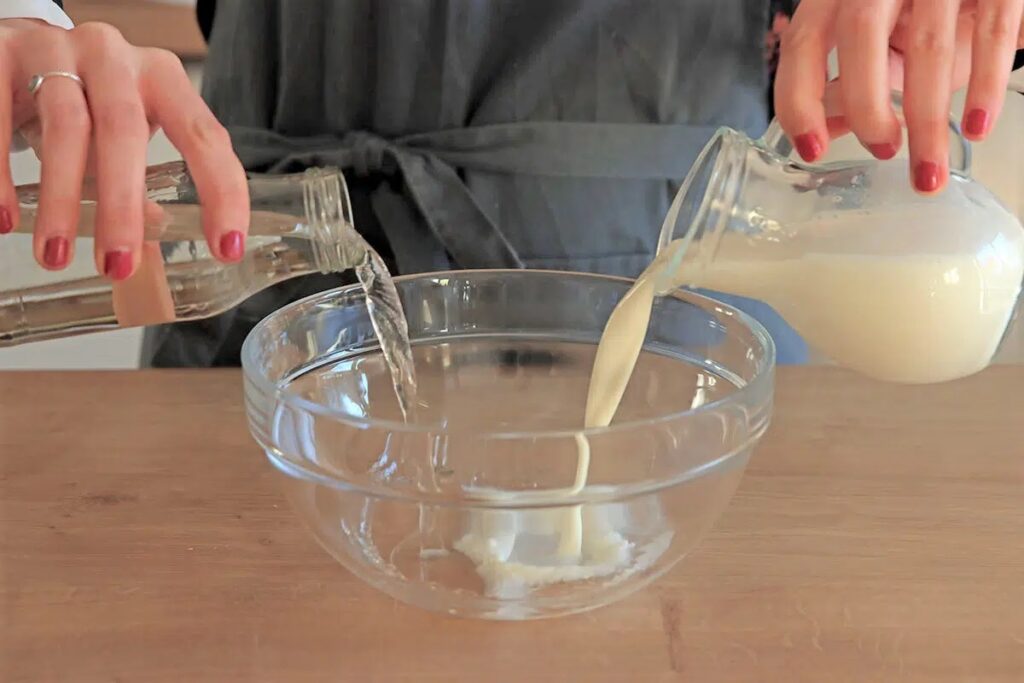Mint is one of the best known herbs. The numerous species and varieties are as diverse as their aroma and pleasant fragrance. But what to do when the mint leaves get white spots?
Contents
White spots on mint leaves
It’s not so much care errors as pests and diseases that are behind the sudden appearance of white spots on your mint. We therefore present the most common causes and the most promising countermeasures here.
Pests as cause
Pests often attack the mint and cause white spots.
Cicadas
Cicadas are one of the most common causes of such leaf spots. These two to four millimeter flying insects are very mobile and have enormous jumping power. At the slightest disturbance, they run, jump or fly away.
Damage
- dot-like white spots or speckles on the leaves
- are caused by the sucking activity of the animals
- white spots appear at the puncture sites
- cicadas and larvae sit on the undersides of leaves
- white spots first on leaf veins
- spread over the whole leaf
- white irregularly shaped formations can be seen in places
- the ejected larval cuticle
- affected plants are weakened, but do not die off
Countermeasures
Control is difficult, but in most cases not necessary, the damage is usually tolerable. If these animals still bother you, you can catch some of them, for example, by means of sticky yellow boards or stickers. If necessary, you can also spray the plants with a water hose to remove the pests.
Prevention
It is advisable to attract natural enemies of cicadas such as predatory mites, chalcid wasps, ground beetles, ichneumons, lacewings and their larvae, and birds to the garden. This can be achieved, for example, by installing nesting boxes, birdbaths and insect hotels, and by creating flower meadows and/or deadwood piles. In addition, pesticides should be avoided completely and only sprays that are gentle on beneficial insects should be used.
Whitefly
Another causative agent of white leaf spots is the whitefly. It can be recognized by a white waxy layer covering its body. If you look closely, you will also spot their jumping legs on their abdomen. Their larvae are yellow, immobile, sit under the leaves and suck plant sap. Mint leaves are also a food source for adults.
Damage
- small white leaf spots and wax layer on leaf undersides
- upper sides of leaves are mottled yellow
- mint leaves dry up and fall off
- sticky honeydew is characteristic for an infestation
- sticky substance serves as food for some beneficial insects
- but it can cause diseases such as stinking smut
Note: Whiteflies can survive mainly in places where it is warm and slightly humid and there is insufficient ventilation. There they can multiply particularly quickly
Control
There are several ways to combat these pesky suckers. First, remove and dispose of all parts of the plant on which eggs, larvae or honeydew can be seen. Additional help is promised by homemade spray solutions.
oil and water
- one part canola oil and three parts water
- mix the two together
- generously spray infested plants with it
- Oil blocks the respiratory openings of the pests, they die
- Repeat spraying after a few days
- several times if necessary
Soap and water
- 40 g soap and one liter of water
- First grate the soap into small pieces
- then dissolve completely in one liter of water
- cover root area with foil before application
- lye should not get on the soil
- apply to infested plant parts
- leave the mixture to act for maximum one hour
- rinse with clear water
Tip: In case of light infestation, treatment with neem extract can also be helpful
Rain fern broth
- from 100 g of fresh ragweed and 1 liter of water
- ideally flowering tansy
- active ingredient content is highest in the flowers
- alternatively, dried herb is also possible
- add herb to water, simmer for half an hour
- strain after cooling
- Dilute the decoction depending on the infestation
- in case of light infestation one part of decoction to ten parts of water
- in case of heavy infestation, one part of decoction to six parts of water
- spray generously on infested plants
- Frequency of spraying depends on success

Basil mix
- two tablespoons of fresh basil, one liter of water
- or dried herb
- pour boiling water over the herb
- infuse for about ten minutes
- cool and strain
- spray plants with the tea
- if necessary several times
Tip: If the mint is grown in a greenhouse, it is a good idea to use natural predators. For example, ichneumon wasps are recommended, which also feed on their eggs in the larvae of the pests.
Prevention
As a preventive measure, care should be taken to ensure optimal care of the mint and a well-ventilated location, changing it more frequently. In addition, it is advisable to combine intensely fragrant plants with the mint, because they can drive away the whitefly. These can be, for example, thyme, sage, basil, but also marigolds.
Diseases as a cause
Causes of white spots on the leaves can also be diseases such as powdery mildew, both powdery and downy. Both are distinguished by their symptoms of damage.
Damage symptoms

- powdery mildew in dry and warm weather (fair-weather fungus)
- initially small white spots on leaf surface
- quickly become larger and merge into
- mint leaves, then covered by white mealy coating
- downy mildew loves moisture
- consequently occurs in warm and humid weather conditions
- onset of infestation on leaf undersides
- with whitish-grey spots
- yellowish spots on upper leaf surfaces
- affected plant parts die
- spread of both species also to flowers and stems
Control
Field horsetail broth
- Horsetail broth also promises help
- is especially effective against downy mildew
- infuse 30 g of herb in two liters of water for one day
- then simmer for half an hour
- strain and let cool
- mix one part of broth with five parts of water and spray
- milk and water

- Mix one part raw milk and nine parts water.
- Spray plants with it several times a week
- Lactic acid bacteria act against the fungus.
Tip: When controlling powdery mildew, the particular species is not relevant
Prevent powdery mildew
As a preventive measure, care should be taken to ensure a well-ventilated site, adequate plant spacing and resistant varieties. Also, mint leaves should not get wet when watered. In addition, field horsetail broth can also be used as a preventive.
Frequently asked questions
Can mildew infested mint still be used?
Theoretically, you can still use it. Powdery mildew is not poisonous and can be washed off. However, it is not advisable to eat it. Sensitive individuals may have an allergic reaction to it.
Can powdery mildew from mint spread to other plants?
Powdery mildew is a highly contagious disease, so it can easily spread to neighboring vegetables or ornamental plants.
Do cicadas change the taste of mint?
Yes, these insect pests suck the plant sap from the leaves. This causes some of the mint flavor to be lost.


